Artland
Artland
RMIT Art and Design
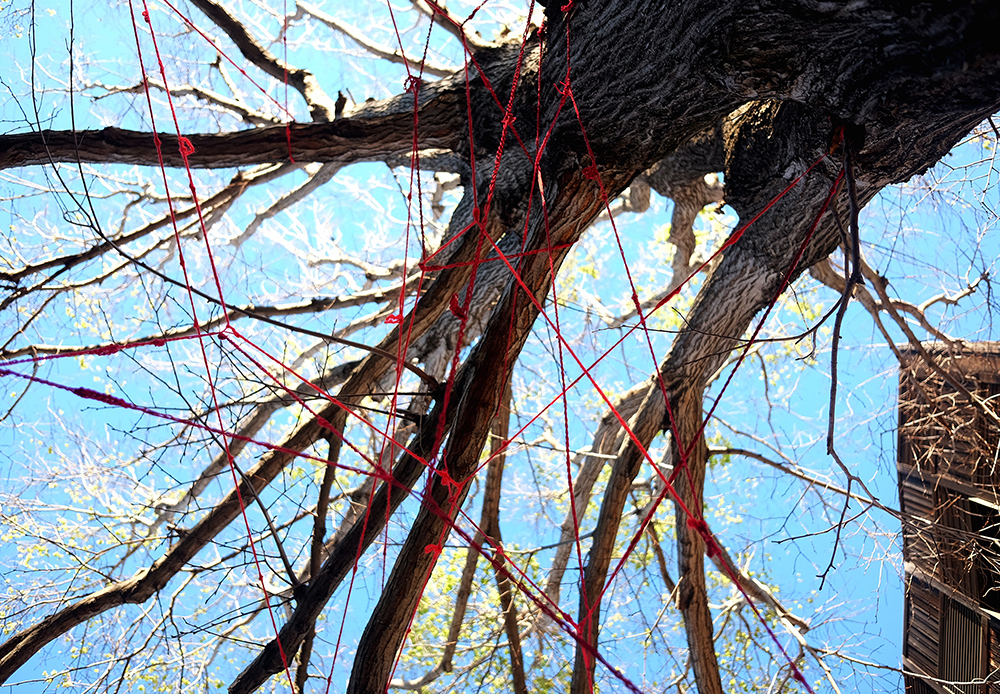
RMIT's Brunswick campus is set to be transformed as part of Artland, RMIT's annual public art exhibition.
In its eighth year, Artland is a group exhibition of site-specific art installations around RMIT’s Brunswick campus. Responding to the theme Thresholds, eight of RMIT's most talented emerging artists have been selected to exhibit as part of Artland...
Javier Bermejo
Julia English
Kristen Brownfield
Mariah Bakhtiar
Mohsen Meysami
Richard MacHuca
Ryoko Kose
Varuni Kanagasundaram
Opening event
Join us at RMIT's Brunswick campus on Thursday 12 October, 5-7pm for the Artland opening event for the artist tour, performances music, along with drinks and nibbles. The winner of the Artland award will also be announced on this evening.
Artland runs from 12 October to 11 November 2017 in conjunction with the MoreArt Public Art Show.
Artists
Javier Bermejo, Note to Self
Textile waste, enamel paint, polyvinyl emulsion, perle yarn, 2017
Note to Self explores frustrations and anxieties surrounding climate change and a desire for sustainable fashion. Through a ceremonial-like process, textile waste is distorted in a solution that creates a rigidity, evolving the pieces from textile to sculpture. A layer of paint is then applied to dissociate the clothes from the concept of abandonment. The pieces are hung to imply a retail setting, which explores the space between self and market, questioning the legitimacy of that boundary when e-commerce and social media are ever present. The palette is composed of a monotonous “Millennial Pink”, the unifying colour for contemporary culture in the artist’s generation. Note To Self is a reflection upon artist Javier Bermejo’s understanding of his own generational identity and is synonymously titled with Connor Franta’s book in an attempt to exclaim today’s copy-paste culture.
Javier Bermejo is currently in his second year of Bachelor of Art (Textile Design).
Julia English, What a waste?
Calico toiles, sisal rope, 2017
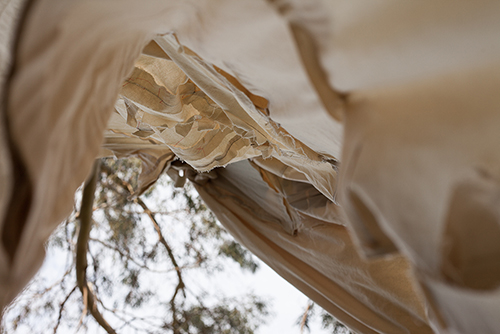
Fashion is the second most polluting industry in the world, and a key part of fashion design is waste, which we are quickly running out of room to hold. Every fashion student in Building 516 has made toiles, the beige test runs that check fit and proportion before the ‘real’ garment is made. Toiles provide students with the space to trial their ideas and to explore new processes, they allow and promote innovation, and are a stepping-stone to a final solution.
Through What a waste? artist Julia English considers the dichotomy of toiles - useless in themselves, but facilitating innovation and discussion. The scale of the work confronts and challenges our excessive fabric use, yet the space that this creates hopes to produce discussion around how we can design better and reduce waste.
Julia English is currently completing a Bachelor of Fashion (Design) (Honours) at RMIT.
Kristen Brownfield, Something somewhere else
Mixed media, dimensions variable 2017
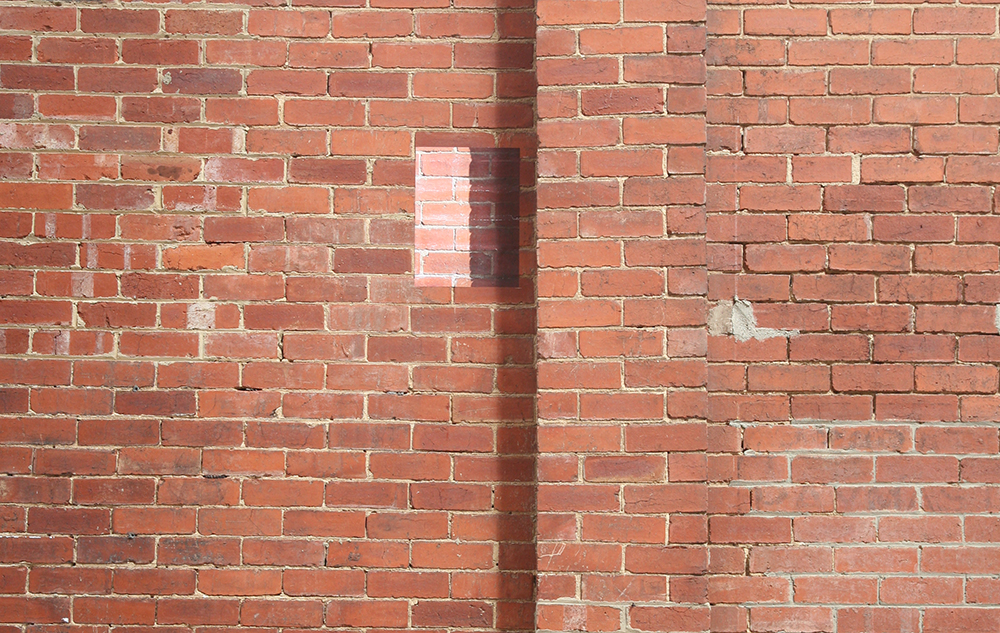
Something somewhere else invites a sense of awareness to the Brunswick campus. It calls attention to the objects and things that inhabit this space. Interventions and rearrangements are situated throughout the campus, though not immediately given. These gestures integrate into the built surroundings and everyday goings-on at the university. Things appear and disappear, interacting with the passing of time. Something somewhere else encourages visitors and those who come here to work and study to reconsider the things that they notice as they move through the space.
Brownfield is documenting Something somewhere else at https://
Kristen Brownfield (1992) is an emerging artist from Perth, currently living in Melbourne. Within her practice she explores perceptual awareness and attention to things and spaces, through site-responsive works, installation and spatial arrangements. Kristen received her BA in Visual Arts in 2015 and is now completing her Honours in Fine Art at RMIT.
Mariah Bakhtiar, Urban Maze
Mesh fabrics, wooden dowels, and hemp yarn, 2017
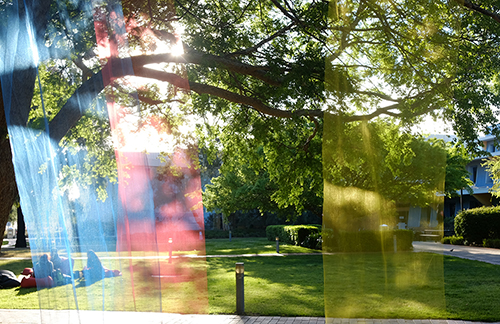
Every individual has their own perceptive filter through which they experience the world. As we meet, interact and connect with others, our filters intersect. The intersection becomes a threshold, bringing another colour, another experience, into their life.
Urban Maze is a series of installation works created by Mariah Bakhtiar in response to human perception and the urban environment. The work aims to engage people in an experience that represents life’s journey and human perception through movement and colour. The installation adds an aesthetic layer of filters to the everyday world, enabling audiences to contemplate their sense of place. Urban Maze invites the viewer to move around and through the work, engage with the varying effects of colour and light.
Mariah Bakhtiar is an Indonesian designer/artist with a background in Interior Architecture with an interest in colour, place, and space. She is currently a candidate in the Master of Arts, Art in Public Space at RMIT University.
Mohsen Meysami, ROAD CLOSED, 2017
Found traffic sign, yarn, fabric, armature wire, ribbon, peg, cable ties, 2017

Through his practice, Mohsen Meysami seeks to challenge indifference towards the fate of people fleeing wars in the Middle-East. Through his related billboard and fence-line works, Meysami challenges the policies that seek to block asylum seekers receiving the support they are legally entitled to. The chain-link fence is used in both artworks to symbolise political force and borders. In his fence-line work, Meysami utilises a found “ROAD CLOSED” traffic sign, usually used to warn people not to enter or cross a threshold. However, being broken, the sign has lost its power.
Meysami grew up amid the Iran-Iraq war, which through its impact on his father’s mental and physical health and the loss of his 15-year-old cousin gives him reason to hate and oppose war. Meysami’s practice is informed by his experience of living in Australia. His recent artworks are the response of an ‘alien’ to xenophobia and the resultant public indifference that does not acknowledge the ‘alien’. Meysami is a PhD candidate in the School of Art.
Richard Machuca, making myself at home
Brick, tape measure, bricklayer’s chalk line tool, chalk, 2017
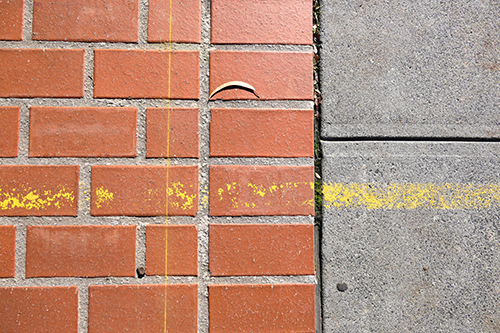
If enclosure is not necessarily a necessity for the creation of an interior, then where does an interior’s boundary lie? Where are the thresholds of such interiors situated? Can they be measured and documented or are they only experienced or perceived? This work seeks to comment on this notion.
Making myself at home uses objects/tools as staging for a performed interior. The work is a series of performances wherein artist Richard Machuca constructs 1:1 chalk floor plans of selected verandas, superimposing them into various outdoor sites within the larger RMIT Brunswick campus site. The actions are documented on digital video and edited for exhibition/presentation. Except for this documentation, the chalk drawings are the only trace left of my inhabitation of site.
Making myself at home makes use of a single brick as a tool for the ‘building’ of interiors through the performance of drawing. Machuca uses a measuring tape and a bricklayer’s tool, the chalk line, to produce the lines of the floor plans. The yellow chalk lines that remain afterward are an impermanent rendering of the ephemeral space created through the drawing performance, and not the threshold of the space itself. Making myself at home foregrounds activity in the creation of interiors, and posits that the interior is not bound by a particular built form or two-dimensional demarcation. It is the interrelationship of the human and their surroundings, a confluence of objects, forces and atmospheres that create the condition of interior. Secondary to this notion, Machuca uses the image of the veranda for its overtly liminal quality. Found in all parts of Australia, it is a ubiquitous space that no longer necessarily exists as a response to its climatic context. Instead, it is a stage for an idealised vision of laidback Australian life. If one agrees with this sentiment, then there is a tension when considering the veranda's inherently colonial origins, and a further space for contemplation created within this work.
Richard Machuca is currently completing a Bachelor of Interior Design (Honours) at RMIT.
Ryoko Kose, Just Keep Going, 2017
Hemp yarn, 2017

In the aftermath of any extreme experience hope is necessary new beginnings, and to reconnect into the continuum of life. Weaving trails of red, a symbol of connection and ultimate destiny in Japanese culture, through the Brunswick campus, artist Ryoko Kose seeks to weave hope through the campus and reconnect people in their daily journey. Just Keep Going is an accumulative work inviting people to accomplish big things despite adversity; it is an offering to the passer-by as they move toward their destiny.
Ryoko Kose is a Melbourne-based artist originally from Japan. Her work draws on her own experiences in the aftermath of the Great Eastern Earthquake and Fukushima nuclear accident that occurred in Japan in 2011. Kose has worked extensively as lead artist on a series of projects with communities post-tsunami in Tokyo. Kose earned her BA (Social Education) from The University of Waseda, and is currently a candidate in the Master of Arts- Art in Public Space at RMIT University. She has exhibited at Testing Grounds in Melbourne and is installing work for Gaswork 2017. She has also exhibited in solo and group shows in Japan, France and Australia.
Varuni Kanagasundaram, Kolam_a Welcome beneath your feet, 2017
Clay slip, water, fired ceramic work and found materials, 2017
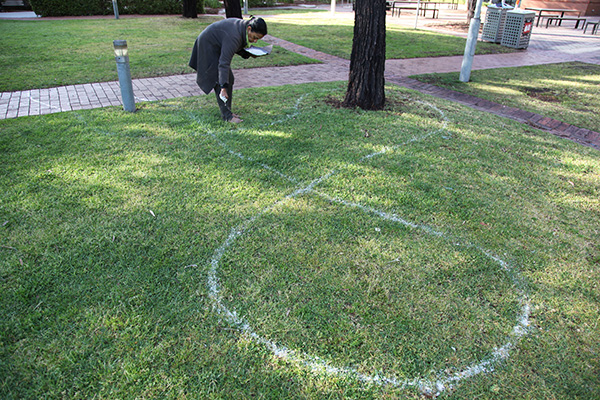
Dispersion of people from their homeland and separation from their cultural connections brings a rich discourse that takes into account the trajectory and translation of the experience of the migrant.
The ritual of Kolam performed by women in parts of Sri Lanka and India marks the threshold of a home and welcomes those who enter. Traditionally the drawing using rice flour, is made at dawn and as the day progresses, it fades as people enter the home. Kolam_a Welcome beneath your feet Kanagasundaram creates the gesture of the Kolam using clay slip and ceramic installation to evoke the journey of a migrant. Kanagasundaram will perform the gesture at intervals over Artland period, evolving as the exhibition progresses. The fragmentation and the fading of the drawing over time conveys the transience experienced by migrants. Gradually elements from the new landscape become part of the Kolam. In the spirit of the Kolam, Kanagasundaram invites people to experience the fragility and beauty in the transience.
Varuni Kanagasundaram is a PhD (Fine Art) candidate at RMIT.
Contact
Please contact linkarts@rmit.edu.au for more information.
Artland is presented by RMIT Link Arts and Culture.
To stay informed subscribe to our mailing list and join us on Facebook.
Artland is proudly supported by


